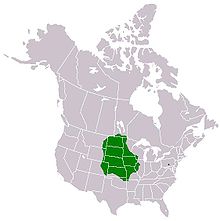Regal fritillary
| Regal fritillary | |
|---|---|
 |
|
 |
|
| Scientific classification | |
| Kingdom: | Animalia |
| Phylum: | Arthropoda |
| Class: | Insecta |
| Order: | Lepidoptera |
| Family: | Nymphalidae |
| Genus: | Speyeria |
| Species: | S. idalia |
| Binomial name | |
|
Speyeria idalia (Drury, 1773) |
|
 |
|
The regal fritillary (Speyeria idalia) is a striking nymphalid butterfly found among some of the remaining tallgrass and mixed-grass prairies in the east-central United States. This prairie-specialist butterfly has a characteristic deep orange color and unmistakable dark hindwings with two bands of spots (Brock 2003). On the female, both bands of spots are white. However, on the male, the outer band of spots is orange in color. Females also tend to be slightly larger than males. The ventral surface of the hindwings is olive brown to black in color with bold silvery white spots (Selby 2007). The wingspan of S. idalia usually measures 68–105 millimetres (2.7–4.1 in) (Selby 2007). Flight is in the summertime from approximately June to September and adults tend to be swift in flight, coasting close to the ground (Brock 2003).
Regal fritillary larvae are approximately 0.08 inches long after they hatch and reach a length of approximately 1.75 inches when fully developed (Edwards 1879). The mature larvae have a black body with yellowish-orange bands and stripes. There are yellowish middorsal and lateral stripes and a number of dorsal, subdorsal, and lateral fleshy spines extending from the body. The head of the mature larvae is rounded and small, orangish-red on top and black underneath (Edwards 1879).
The larval food source for the regal fritillary and all members of the genus Speyeria are violets (Viola spp.) (Selby 2007). The violets are an extremely important component of habitat sustainability for the regal fritillary and there is a correlation between the number of violets present and the number of butterflies found in a given area (Kelly and Debinski 1998). Violet species that the larvae feed on include Viola pedata (bird’s-foot violet), V. pedatifida (blue prairie violet), V. papilionacea (common blue violet), V. lanceolata (lance-leafed violet), V. nuttallii (Nuttall’s Violet) (Kelly and Debinski 1998), V. sagittata (arrowleaf violet), and V. tricolor (Johnny Jumpup) (Selby 2007). These various violet species are associated with the different areas of the regal fritillary’s range. For example, the bird’s-foot violet and the prairie violet tend to be the preferred larval food source for the regal in the Midwest and Great Plains regions (Selby 2007).
...
Wikipedia

